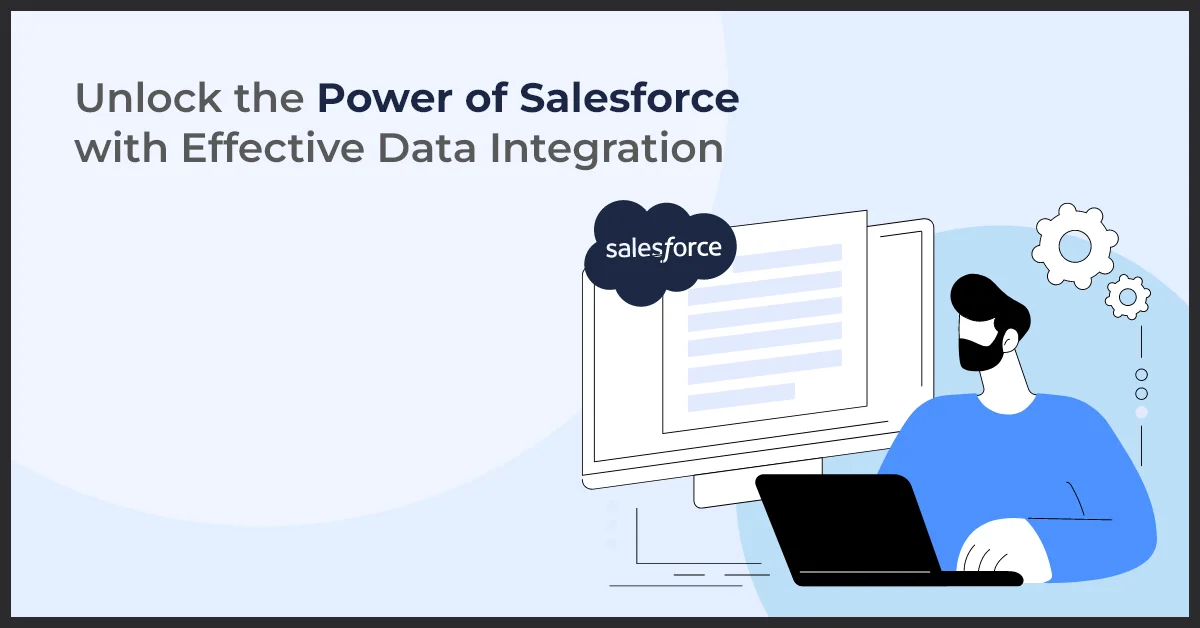Unlock the Power of Salesforce with Effective Data Integration

Published on: November 2, 2023
Updated on: April 10, 2024
1828 Views
- Salesforce
10 min read
As one of the most renowned platforms in the business world, Salesforce offers a myriad of benefits for organizations of all sizes. From streamlining sales processes to enhancing customer relationships, Salesforce has proven to be an invaluable tool for driving business growth. However, to fully maximize its potential, a robust data integration strategy is essential.
Data integration is the process of combining and managing data from various sources to provide a unified view. When it comes to Salesforce, this means bringing in data from multiple systems, such as customer relationship management (CRM), marketing automation, and financial systems, to provide a comprehensive understanding of customers and prospects.
Having a well-defined data integration strategy is crucial as it enables businesses to make informed decisions, identify trends, and gain a holistic view of their operations. By seamlessly integrating data, organizations can enhance their Salesforce experience, drive operational efficiency, and accelerate business growth.
Understanding Data Integration
Data Integration is the process of combining data from different sources and making it available in a unified format. It plays a crucial role in connecting disparate systems within an enterprise, enabling seamless data flow and providing a holistic view of information.
One of the key benefits of data integration is its ability to improve operational efficiency and decision-making. By consolidating data from various systems, organizations can gain valuable insights and make informed business decisions.
However, data integration initiatives often come with challenges. The complexity of integrating different data sources, disparate data formats, and ensuring data quality are some of the common hurdles faced by enterprises.
- Integrating different data sources: Data integration involves linking data from various sources such as databases, applications, and cloud services. This requires a robust integration strategy and tools that can handle different data formats and protocols.
- Disparate data formats: The data being integrated may be in different formats, such as structured, unstructured, or semi-structured. Transforming and mapping the data to a common format is essential for successful integration.
- Data quality: Ensuring the accuracy, completeness, and consistency of data during integration is crucial. Data cleansing and validation processes are necessary to maintain data integrity.
To overcome these challenges, enterprises need a comprehensive data integration solution that can handle complex data integration requirements and provide seamless connectivity between systems.
Salesforce Data Integration: Key Concepts
In order to effectively integrate data with Salesforce, it is crucial to understand the key concepts associated with Salesforce data integration. Familiarizing yourself with these concepts will enable you to make informed decisions and efficiently manage data within the Salesforce platform.
Data
Data refers to any information or records that are stored within a system or database. It can include various types of data such as customer details, sales figures, product inventory, and more.
Integration
Integration involves combining different datasets and systems together in order to enable seamless communication and data flow between them. It ensures that data from various sources is consolidated and accessible within a unified platform.
Salesforce
Salesforce is a powerful CRM (Customer Relationship Management) platform that provides businesses with the tools and functionality to manage their customer data effectively. It offers a range of features and capabilities for sales, marketing, customer service, and more.
Product
In the context of Salesforce data integration, a product refers to any software or tool that facilitates the integration process. These products are specifically designed to connect various systems and databases with Salesforce, enabling seamless data transfer and synchronization.
Tool
A tool, in the context of Salesforce data integration, refers to a specific software or technology that assists in the integration process. These tools often provide functionalities such as data mapping, transformation, and synchronization.
Platform
A platform refers to the underlying infrastructure or system that supports the integration process. In the case of Salesforce data integration, the Salesforce platform serves as the foundation for integrating and managing data from multiple sources.
Enterprise
Enterprise, in the context of Salesforce data integration, refers to a large organization or business entity. Salesforce data integration solutions are often designed to meet the complex data integration needs of enterprises.
Customer
A customer refers to an individual or organization that interacts with a business and utilizes its products or services. Effective Salesforce data integration ensures that customer data is accurately captured and available for analysis and decision-making.
Custom
Custom, in the context of Salesforce data integration, refers to tailored or specific requirements that businesses may have for their data integration processes. Customization allows organizations to align their Salesforce data integration solutions with their unique needs and workflows.
Feature
A feature refers to a specific functionality or capability within a software or tool. In the context of Salesforce data integration, features can include data mapping, real-time integration, scheduling, and other functionalities that enhance the integration process.
Understanding these key concepts is vital for effective Salesforce data integration. It enables businesses to align their data integration strategies with their specific requirements and maximize the value of their Salesforce platform.
Available Salesforce Data Integration Solutions
When it comes to Salesforce data integration, there are multiple solutions available in the market. These tools and platforms offer various features, capabilities, and pricing options. It's essential to understand the options and consider specific business needs before selecting the right integration tool.
Overview of Various Salesforce Data Integration Tools and Platforms
There are numerous Salesforce data integration tools and platforms that cater to different requirements. Some commonly used solutions include:
- Salesforce Connect
- Jitterbit
- Informatica Cloud
- Dell Boomi
- Talend
- Mulesoft
Each of these tools offers unique features, such as real-time data synchronization, automation workflows, and easy data mapping.
Comparison of Features, Capabilities, and Pricing
It's crucial to compare the features, capabilities, and pricing of different Salesforce data integration solutions before making a decision. Factors to consider include:
- Supported data sources and formats
- Data transformation and mapping capabilities
- Real-time or batch integration options
- Scalability and performance
- Security and compliance
- Vendor support and reputation
- Cost and licensing model
Consideration Factors for Selecting the Right Integration Tool
Choosing the right Salesforce data integration tool depends on specific business needs. Factors to consider include:
- Integration complexity and scalability
- Existing IT infrastructure and applications
- Data volume and frequency
- Business requirements and objectives
- Integration team expertise
By considering these factors, organizations can select the most suitable Salesforce data integration solution that aligns with their business objectives.
Common Salesforce Data Integration Scenarios
When it comes to Salesforce data integration, there are several common scenarios that organizations often encounter. By understanding these scenarios, businesses can effectively leverage Salesforce's capabilities and integrate it with other systems or platforms. Let's take a closer look at some of these scenarios:
Integration with CRM systems:
Leveraging Salesforce's CRM capabilities alongside other CRM platforms can provide organizations with a unified view of their customer data. This integration allows for seamless data sharing, ensuring that the sales team has access to comprehensive customer information.
Cloud computing integration:
Enabling seamless data transfer between Salesforce and other cloud-based applications is crucial for organizations that rely on different cloud environments. By integrating Salesforce with other cloud platforms, businesses can ensure that data flows seamlessly, leading to enhanced collaboration and improved business processes.
API-driven integrations:
Utilizing APIs to connect Salesforce with external systems or platforms is a popular approach to data integration. APIs provide a standardized method for data exchange, allowing organizations to automate processes and streamline data transfer between Salesforce and other systems.
Multi-cloud integration:
Integrating Salesforce with multiple cloud environments can be advantageous for businesses that utilize multiple cloud platforms. This integration enables enhanced data sharing and ensures that data remains consistent across various cloud environments, facilitating better decision-making and collaboration.
Best Practices for Salesforce Data Integration
Planning and strategizing integration projects
Before starting any Salesforce data integration project, it is crucial to carefully plan and strategize the process. This involves understanding the business needs, identifying the data sources, determining the integration goals, and defining the scope of the project. Proper planning ensures that the integration is aligned with the organization's objectives and minimizes the risk of data inconsistencies or errors.
Ensuring data quality and managing data governance
One of the key aspects of Salesforce data integration is maintaining data quality. It is important to establish data governance practices and guidelines to ensure the accuracy, completeness, and consistency of the integrated data. This includes implementing data validation rules, data cleansing techniques, and conducting regular data audits to identify and resolve any data quality issues.
Implementing secure data privacy measures and maintaining compliance
When integrating Salesforce with other systems, data security and privacy should be a top priority. Organizations should implement robust security measures to protect sensitive data and ensure compliance with relevant regulations such as GDPR or HIPAA. This may include encrypting data, implementing access controls, and regularly monitoring and auditing data access and usage to maintain data privacy.
Data synchronization and real-time updates
For seamless Salesforce data integration, it is essential to establish efficient data synchronization processes. This ensures that data is consistently updated and reflects the latest changes across all integrated systems in real-time. Using tools and technologies that support real-time updates, organizations can avoid data inconsistencies and provide accurate and up-to-date information to their users.
Extract, Transform, Load (ETL) processes and their significance in integration initiatives
ETL processes play a crucial role in Salesforce data integration. Extracting data from various sources, transforming it into a consistent format, and loading it into Salesforce ensures that the integrated data is standardized and usable. Implementing efficient ETL processes reduces the complexity of data integration and enables organizations to leverage the full potential of their integrated systems.
Importance of data connectors, adapters, and integration platforms
Data connectors, adapters, and integration platforms simplify the Salesforce data integration process by providing pre-built connectors or adapters for connecting with different systems and applications. These tools enable seamless data flow between Salesforce and other systems, reducing the time and effort required for integration. Choosing the right data connectors, adapters, or integration platforms that align with the organization's requirements significantly enhances the integration success rate.
Conclusion
Unlock the full potential of your Salesforce platform with seamless data integration. By now, you should have a clear understanding of the importance of data integration and its role in optimizing business processes. Salesforce data integration enables you to centralize your data and gain a holistic view of your customers, sales, and operations.
Seamless integration offers a multitude of benefits for enterprises, including accurate and real-time data synchronization, improved data quality, enhanced reporting and analytics, and streamlined workflows across systems. It eliminates manual data entry, reduces errors, and empowers your teams with the most up-to-date information.
To stay competitive in today's data-driven world, it is crucial for businesses to invest in a comprehensive data integration strategy. Whether you are a small startup or a large enterprise, integrating your Salesforce data with other systems can provide you with valuable insights, improve decision-making, and maximize the efficiency of your operations.
Don't let disjointed systems and siloed data hold you back. Take the leap and harness the power of Salesforce data integration to elevate your business to new heights. Get started today and experience the transformative impact of seamless data integration.



